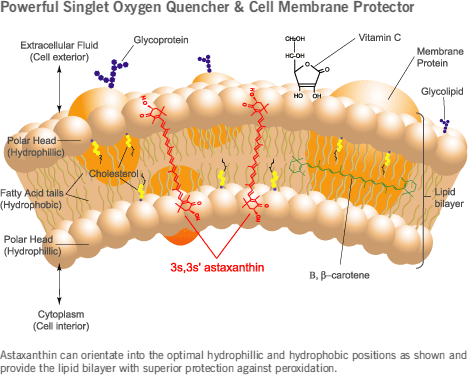How does Astaxanthin work?
 Astaxanthin is a lipid soluble carotenoid antioxidant. Upon ingestion astaxanthin can be found in all organs of the body. At the cellular level astaxanthin accumulates in the membranes of cells and in the membranes of mitochondria and many others. Astaxanthin has a unique structure that enables the molecule to span the double layer membrane and consequently, exposes itself both to the interior as well as the exterior of the cell. By localizing itself in the membranes, astaxanthin protects membrane components like proteins and unsaturated fatty acids from ROS mediated oxidation. Furthermore, this high antioxidant capacity can inhibit the activation of the proinflammatory response via the NF-kB dependent pathway.
Astaxanthin is a lipid soluble carotenoid antioxidant. Upon ingestion astaxanthin can be found in all organs of the body. At the cellular level astaxanthin accumulates in the membranes of cells and in the membranes of mitochondria and many others. Astaxanthin has a unique structure that enables the molecule to span the double layer membrane and consequently, exposes itself both to the interior as well as the exterior of the cell. By localizing itself in the membranes, astaxanthin protects membrane components like proteins and unsaturated fatty acids from ROS mediated oxidation. Furthermore, this high antioxidant capacity can inhibit the activation of the proinflammatory response via the NF-kB dependent pathway.
Irreplaceable Molecule for any Anti-Aging Regimen
When a shrimp is cooked, it suddenly turns red. The red color is Astaxanthin- a carotenoid xanthophyll that tints salmon, crab, krill and lobster with vivid reddish pigmentation. The rising popularity of astaxanthin as anti-aging nutraceutical supplementation and cosmeceutical application has been endorsed by acclaimed researchers, health specialists and professional athletes worldwide as well as being featured in many nutritional regimens in popular mass media.

